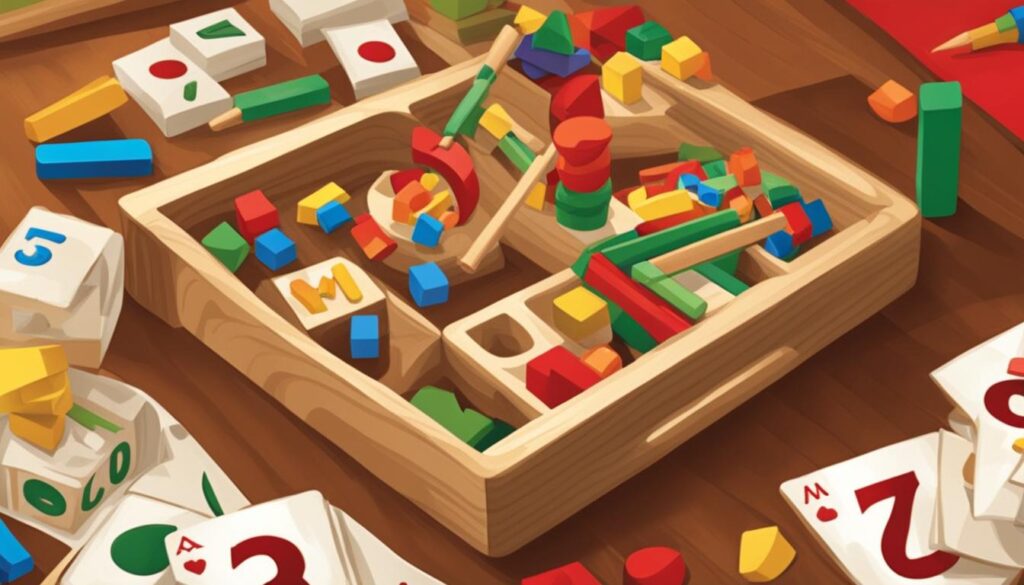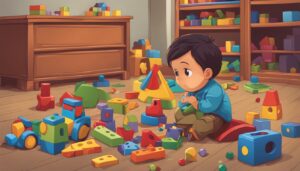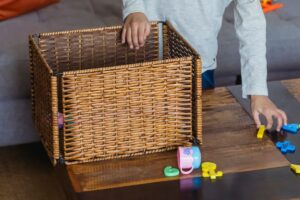Welcome to our article on what makes a toy Montessori! If you’re curious about Montessori toys, their principles, and educational benefits, you’ve come to the right place. Montessori toys are specifically designed to align with the Montessori learning philosophy, which emphasizes independence, hands-on exploration, and problem-solving.
In selecting Montessori toys, various characteristics come into play. These toys prioritize simplicity, educational value, and the use of natural materials. Montessori toys are known for their realism, open-endedness, and ability to foster independence. They also provide sensory stimulation, encouraging children to engage their senses while learning and playing.
The educational benefits of Montessori toys are vast. They promote hands-on learning, fostering focus and concentration. Moreover, these toys aid in the development of practical life skills, preparing children for the real world. So, what exactly are the principles that make a toy Montessori? Let’s explore further.
Key Takeaways:
- Montessori toys align with the Montessori learning philosophy and promote independent exploration and problem-solving.
- These toys are selected based on characteristics such as simplicity, educational value, and the use of natural materials.
- Montessori toys foster hands-on learning, focus and concentration, and the development of practical life skills.
- Open-ended toys are highly valued in Montessori education, as they encourage exploration, problem-solving, and creativity.
- Realistic and educational materials are essential in Montessori toys, helping children understand the world and promoting sensory stimulation.
The Importance of Open-Ended Toys in Montessori Education
In a Montessori environment, open-ended toys play a crucial role in fostering a child’s learning and development. These toys offer numerous benefits that align with the principles of Montessori education and support children’s natural curiosity, problem-solving abilities, and creativity.
Unlike battery-powered toys that dictate the child’s play experience, open-ended toys empower children to take charge of their own learning journey. These toys provide endless possibilities and encourage children to use their imagination, critical thinking skills, and initiative.
Montessori toys are often crafted from natural materials such as wood, which offer various textures, colors, and sensory experiences. The tactile qualities of these materials stimulate children’s senses and promote their sensory exploration and sensitivity.
Selecting the right Montessori toys involves considering their characteristics, materials, and features. It’s important to choose toys that promote independent thinking, concentration, and skill development, while also allowing for free exploration and self-expression.
Characteristics of Montessori Toys:
| Characteristics | Description |
|---|---|
| Open-endedness | Encourages creativity and limitless play possibilities. |
| Simple design | Focuses on the essential elements of a toy for minimal distractions. |
| Natural materials | Enhances sensory experiences with textures, colors, and temperatures. |
| Realistic representations | Presents accurate and relatable representations of objects and experiences. |
Montessori toy materials often include building blocks, puzzles, manipulatives, art supplies, and imaginative play sets. These toys foster independent exploration, problem-solving, fine motor skills, and cognitive development.
When selecting Montessori toys for education purposes, remember to prioritize open-endedness, simplicity, natural materials, and realistic representations. By providing children with the right toys, you can create an environment that encourages their natural curiosity, promotes independent thinking, and supports their overall development.
The Role of Realistic and Educational Materials in Montessori Toys

Montessori toys are designed to prioritize the use of realistic and educational materials. They aim to provide children with accurate representations of the real world, enabling them to make sense of their surroundings and enhance their understanding of the world. Through the use of real photographs, replicas of objects, and books that feature real-life experiences, Montessori toys offer a rich and immersive learning experience.
By incorporating realistic materials into their play, children can develop a deeper connection to their environment and gain a greater understanding of the world around them. These materials not only engage their imagination but also promote critical thinking and problem-solving skills. Whether it’s exploring a miniature kitchen set or examining a life-like plant replica, Montessori toys encourage children to investigate and interact with their surroundings in a meaningful way.
One of the key principles of Montessori education is the promotion of sensory stimulation and development. Montessori toys achieve this by utilizing materials that offer different textures, temperatures, and weights. By engaging multiple senses, children can develop concrete skills and deepen their learning experiences. For example, playing with wooden blocks of varying sizes and shapes not only enhances fine motor skills but also introduces concepts of geometry and spatial awareness.
| Benefits of Realistic and Educational Materials in Montessori Toys | Examples |
|---|---|
| Promote understanding of the real world | Replicas of animals, plants, and everyday objects |
| Encourage critical thinking and problem-solving | Puzzles, building sets, and interactive games |
| Develop sensory skills | Toy instruments, textured materials, and sensory boards |
| Enhance fine motor skills | Wooden puzzles, threading toys, and lacing cards |
When selecting Montessori toys, it is important to consider the materials used and their educational benefits. Look for toys that provide realistic representations of the world, involve multiple senses, and encourage exploration and independent learning. By incorporating these features into their playtime, children can reap the full benefits of Montessori principles and further develop their cognitive, physical, and social-emotional skills.
The Importance of Minimalism and Practical Life Skills in Montessori Toys
Montessori toys are designed with a focus on minimalism and practical life skills, aiming to provide children with meaningful play experiences that promote independence and self-sufficiency. Unlike toys with excessive features or activities that can distract children, Montessori toys offer a simple and focused approach to play and learning.
These toys provide multiple possibilities for children to engage in activities such as pouring, cleaning, setting the table, and even simulated cooking. By encouraging these practical life skills through play, Montessori toys help children develop a sense of responsibility and become capable members of their families and communities.
With Montessori toys, children can experience the joy of using their hands and bodies to learn, fostering a deeper connection between their actions and the world around them. Through these tactile and interactive experiences, children develop important fine motor skills, hand-eye coordination, and concentration. They also learn problem-solving techniques and gain a sense of accomplishment as they complete tasks.
When selecting Montessori toys, look for ones that embody these principles. Choose toys that are simple, open-ended, and allow for exploration and creativity. Toys made from natural materials like wood and cloth are often preferred as they provide a sensory-rich experience. Additionally, consider toys that encourage practical life skills, such as pouring toys, cleaning sets, and play kitchen items.
FAQ
Q: What makes a toy Montessori?
A: Montessori toys align with the Montessori learning philosophy and promote independent exploration, problem-solving, and hands-on learning. They are selected based on characteristics such as simplicity, educational value, use of natural materials, realism, open-endedness, fostering independence, and providing sensory stimulation.
Q: Why are open-ended toys important in Montessori education?
A: Open-ended toys allow children to explore natural forces, problem-solving, and creativity. Unlike battery-powered toys, open-ended toys require children to use their own energy and engage in meaningful play. They foster independence and provide multiple possibilities for play and learning.
Q: What role do realistic and educational materials play in Montessori toys?
A: Montessori toys prioritize the use of realistic materials like real photographs, replicas of objects, and books that feature real-life experiences. These materials help children make sense of their surroundings and enhance their understanding of the world. Montessori toys also focus on educational materials that stimulate multiple senses, aiding in the development of concrete skills.
Q: Why is minimalism and practical life skills important in Montessori toys?
A: Montessori toys embrace minimalism to minimize distractions and provide focused learning experiences. They prioritize practical life skills by encouraging activities like pouring, cleaning, setting the table, and cooking. These toys promote independence, self-sufficiency, and the development of a sense of responsibility.




